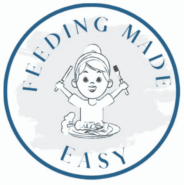When babies are first starting to eat, it’s very common for them to put too much food in their mouth leading to mouth stuffing or food pocketing. It may actually take them a while to realize that they need to swallow their food. Many babies will figure out what they need to do on their own, but there are some tips and tricks you can use to help them figure it out.
This post may contain affiliate links and when you click on the links I may earn a small commission at no charge to you. As an Amazon affiliate, I earn a commission from qualifying purchases.
Ask for Help
If you have any concerns, trust your gut and speak with your pediatrician. They can refer you to a feeding therapist who can rule out any potential problems. The occupational therapist or other feeding therapist should also be able to provide you with individualized tips for your child.
Some children may be hyposensitive and may not realize that their mouth is full until it is very full. These kids would benefit from tips beyond generalized advice (1).
Model
One of the reasons I recommend family meals so often is that it gives your baby a chance to see what you do. If they see you chewing and swallowing, they will realize they should probably be doing the same thing.
Cues
Within modeling, you can also narrate what you’re doing as verbal cues for your baby. There are a few steps in the process of taking a bite and swallowing and a child may get stuck at any point in the process.
Taking a Bite
The first step is taking a bite. There are several techniques to encourage your child to take a bite:
- Offer foods so big that your child has no choice but to take a bite
- Offer foods that are long and stick shaped to encourage a bite
- Offer smaller foods in 1 bite portions so that your child cannot stuff multiple portions in their mouth at a time
- Mark on the food where you would like for them to take a bite so that they can practice
- Have a mirror at the table so that your child can watch themselves take a bite
- Offer food with a dip and dip the food to the point where you want your child to take a bite
Pulling the Food Away
This is something we do so instinctually that we often forget to show it to our kids. After we take a bite of our food, we need to pull it away. Until your child gets this concept, it can be helpful to really exaggerate this motion. Many kids will realize they need to take a bite, but will continue biting and adding food without ever pulling the food away.
Chewing
If your baby is very young, the food they receive should be pretty soft. They may not need to do much chewing. If they are older, they may be able to handle more textures. Either way, you should be cueing them to chew. It doesn’t matter if they have teeth. Their gums are very strong.
You can also encourage your child to chew a certain number of times if you think that will help to pace them. If you think it will become too rigid of a rule, I would skip this step. You know your child best.
Swallowing
If your kid is stuffing their mouth, they’re probably having trouble with this step. They may not understand the cue “swallow.” You may want to use words they are more familiar with like the food is going down the tunnel or the tube. Point to your own throat as your are saying this. This should help them get the idea.
Check Their Mouth
When your baby is young, it can be a good habit to check their mouth at the end of every meal. This way if they are mouth stuffing, you can find any food that may be hidden. When you are actively working with them on chewing and swallowing you can ask them to playfully show you their mouth in between bites.
When they go to take another bite, you can ask if their mouth is empty. Have them open their mouth to show you. Make it fun and silly. It’s not the best table manners, but it will train them to think about whether their mouth is empty before they take another bite.
Pacing
This is a situation where you know your child best. Some kids will overstuff their mouth because they are trying to get in as much food as possible due to a feeling of scarcity. These kids will do better with more food on their plates at mealtimes and the knowledge that more food is available.
Other kids will do better if you only give them a couple of bites of a food at a time. These kids need you to help pace them. Once they finish what’s on their plate, you can give them a couple more bites of food. You can still follow the division of responsibility and allow them to choose what and how much to eat, you just control how much is on their plate at any moment so that they can’t put too much in their mouth at any time.

Krystyn Parks is a Registered Dietitian and Lactation Consultant who specializes in feeding children. She has a Master’s Degree in Nutritional Science from California State University Long Beach. She is an International Board Certified Lactation Consultant and has been registered with the Commission on Dietetic Registration since 2013.
